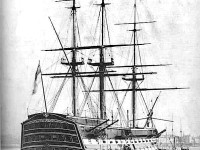The HMS Victory is still the oldest English warship and gained fame particularly in the Battle of Trafalgar against the Spanish Armada and the fleet of Napoleon. Even today, it is used as the flagship of the First Sea Lord in the English Navy.
Launching and design:
In 1758 English ministers proclaimed a major naval program to enforce British claims and interests on the oceans by warships. For this purpose, a program was launched, which should emerge from the construction of 12 new liners. One of them was the HMS Victory whose launching took place on May 7, 1765.
Equipped with 3 masts, the ship reached a maximum speed of around 9 kn (17 km / h). In addition, it was equipped with 104 cannons of different caliber.
The mission until the Battle of Trafalgar:
From the commissioning 1768-1778 Victory was stationed in the reserve service in Chatham, since at that time such a large warship was not needed. Only when the French support the American independence movement militarily, the ship was reactivated.
The first naval battle took place on July 27, 1778 with French ships when they launched their port Brest. Due to the bad weather conditions, the French, unlike the English, could not accept any combat formation, so the tactical advantage lay with the English. But despite this advantage, the French ships sailed past the English and no persecution was recorded through poor communication.
In December 1781, the second naval battle of Ouessant took place when the English Rear Admiral Richard Kempenfelt was ordered to provide the expiring French fleet from Brest. However, when he became aware of the French supremacy during the battle, he was content with the conquest of 15 convoy ships and retired.
From 1782 was again the reserve service for the Victory, which served first in Portsmouth, then in the English Channel and then in the Mediterranean. There she participated in several battles against French ships.
From 1796 England was at war against France and Spain. In February 1797, a meeting took place at Cape St. Vincent between the English fleet led by Admiral Sir John Jervis and the Spanish fleet. Surprised and without formation, the Spaniards tried to pierce the English lines, but had to take heavy damage to their ships and began the retreat.
From 1797 to 1799, the Victory was decommissioned after an investigation and used as a hospital ship after structural shortcomings were recognized. It was not until 1800 that the ship was returned to the shipyard and overhauled until 1803, when it was re-used under the leadership of Lord Nelson in the Mediterranean.
Battle of Trafalgar:
In 1805, the French ruler Napoleon pursued the goal of a great invasion of England. To accomplish this plan, Vice Admiral Pierre Charles de Villeneuve was to divert the English Royal Navy by sailing with his ships to the West Indies island, attacking the English possessions there and then returning to Brest with his ships, where he joined the unite the French Atlantic Fleet. The diversion began on schedule as Villeneuve moved towards the West Indies, following Lord Nelson on the Victory, 8 battleships and 2 frigates. But when Villeneuve turned his ships towards Europe, Nelson realized the plan and sailed to meet his fleet.
On July 22, 1805, Cape Finisterre fought where two Spanish ships could be captured before the view became too bad for the continuation of the battle. Villeneuve retired with his ships to the port of Cadiz, while the English then blocked it. Under threat of Napoleon's ousting Napoleon, Villeneuve ordered his ships to leave port on 19 October. About 40 kilometers south of Cadiz, the English made the expired ships and could win a decisive victory. During this battle, Nelson was hit by a musket ball and died on the Victory after being informed of the victory.
Their operations until after the Second World War:
From 1806 to 1812, the Victory was used mainly as a troopship and escort ship.
In 1812 she was retired and again undergone a major renovation.
From 1824 to 1903, the ship was mainly used as the flagship of the port admiral of Portsmouth or served as accommodation for captains.
In 1903 she was rammed by the tower ship HMS Neptune and was almost lost. After repair, it was moored until 1922 in the port of Portsmouth, which significantly deteriorated the general condition of the ship. To preserve the ship, the Victory was brought to its present berth, the dock 2, and extensively restored. The state of the ship was to be restored at the time of the Battle of Trafalgar, the work ended on July 17, 1928.
During the 2nd World War, the ship was easily damaged by an aerial bomb and had to be restored again.
The Victory after the war:
After World War II, the Victory was awarded by Philip Watts, an English shipbuilding engineer and Director of Naval Construction, to preserve the history and naval tradition of The Westminster Abbey of the Royal Navy.
Today she is subordinate to the Commander in Chief of the Royal Navy and is used for official receptions and events. In addition, tourists can visit the ship.
Ship data:
| Launching | May 7, 1765 |
| Country | England |
| Whereabouts | Still lying today in the Historic Dock Yards in Portsmouth |
| Number of masts | 3 |
| Sails | Frigate rigging |
| Sail area | 5440 square meters |
| Length | 69,3 meters |
| Width | 15,8 meters |
| Draft | 8,76 meters |
| Displacement | 3500 metric tons |
| Speed | Maximum 9 knots (approx. 17km/h) |
| Arming | 2 x 68-Pounder carronades 30 x 32-Pounder 28 x 24-Pounder 44 x 12-Pounder |
This post is also available in:
 Deutsch (German)
Deutsch (German)  Français (French)
Français (French)  Italiano (Italian)
Italiano (Italian)  简体中文 (Chinese (Simplified))
简体中文 (Chinese (Simplified))  Русский (Russian)
Русский (Russian)  Español (Spanish)
Español (Spanish)  العربية (Arabic)
العربية (Arabic)















